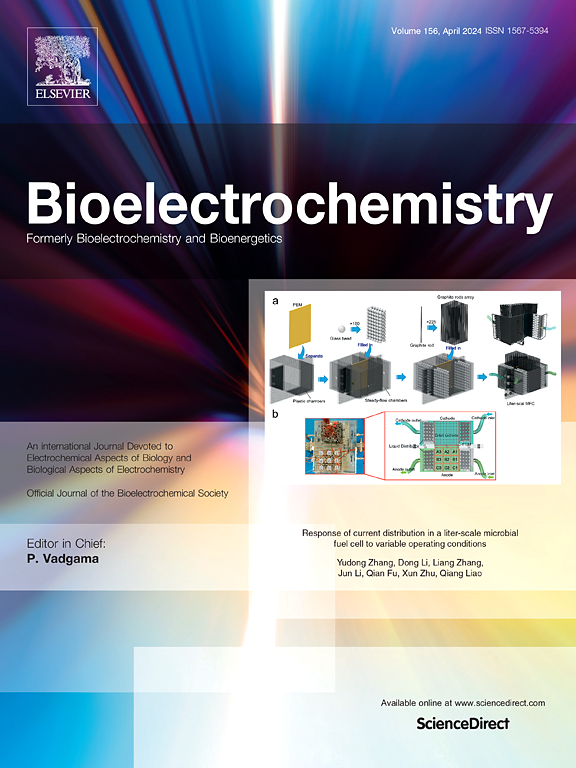Construction of a simple PEC immunosensing platform based on polydopamine and PEDOT sensitized Bi2WO6 for sensitive detection of carcinoembryonic antigen
IF 4.5
2区 化学
Q1 BIOCHEMISTRY & MOLECULAR BIOLOGY
引用次数: 0
Abstract
Organic-inorganic composite photoactive materials can combine the merits of organic and inorganic components and show better performance in comparison with single-component materials. In this work, a novel photoactive material was synthesized through chemical polymerization of 3,4-ethylenedioxythiophene (EDOT) on the surface of hydrothermally prepared Bi2WO6, followed by modification of self-polymerized dopamine (PDA). The integration of poly(3,4-ethylenedioxythiophene) (PEDOT) and Bi2WO6 effectively facilitated the separation of photogenerated electron-hole pairs, thus demonstrated substantially strong photoelectrochemical signal compared to pure Bi2WO6. The PDA film, with abundant functional groups, could further sensitize the material and facilitate the immobilization of recognition units. As a proof of application, the composite was combined with carcinoembryonic antibody to construct an immunosensor for carcinoembryonic antigen sensing. Resultantly, although the components and construction procedure were simple, the prepared sensor demonstrated a broad linear detection range of 0.001–20 ng/mL and a relative low detection limit of 0.50 pg/mL. It also showed high selectivity and stability. Its practical feasibility was confirmed by detecting real samples and yielding satisfactory results.

基于聚多巴胺和PEDOT致敏Bi2WO6的简易PEC免疫传感平台的构建,用于癌胚抗原的敏感检测
有机-无机复合光活性材料结合了有机和无机组分的优点,与单组分材料相比具有更好的性能。本研究通过在水热法制备的Bi2WO6表面化学聚合3,4-乙烯二氧噻吩(EDOT),并对自聚合多巴胺(PDA)进行修饰,合成了一种新型光活性材料。聚(3,4-乙烯二氧噻吩)(PEDOT)与Bi2WO6的集成有效地促进了光生电子-空穴对的分离,因此与纯Bi2WO6相比,显示出明显强的光电信号。PDA膜具有丰富的官能团,可以进一步敏化材料,便于识别单元的固定。作为应用证明,将该复合物与癌胚抗体结合,构建了用于癌胚抗原检测的免疫传感器。结果表明,该传感器的组成和构建过程简单,线性检测范围为0.001 ~ 20 ng/mL,检出限较低,仅为0.50 pg/mL。结果表明,它具有较高的选择性和稳定性。通过对实际样品的检测,验证了该方法的可行性,并取得了满意的结果。
本文章由计算机程序翻译,如有差异,请以英文原文为准。
求助全文
约1分钟内获得全文
求助全文
来源期刊

Bioelectrochemistry
生物-电化学
CiteScore
9.10
自引率
6.00%
发文量
238
审稿时长
38 days
期刊介绍:
An International Journal Devoted to Electrochemical Aspects of Biology and Biological Aspects of Electrochemistry
Bioelectrochemistry is an international journal devoted to electrochemical principles in biology and biological aspects of electrochemistry. It publishes experimental and theoretical papers dealing with the electrochemical aspects of:
• Electrified interfaces (electric double layers, adsorption, electron transfer, protein electrochemistry, basic principles of biosensors, biosensor interfaces and bio-nanosensor design and construction.
• Electric and magnetic field effects (field-dependent processes, field interactions with molecules, intramolecular field effects, sensory systems for electric and magnetic fields, molecular and cellular mechanisms)
• Bioenergetics and signal transduction (energy conversion, photosynthetic and visual membranes)
• Biomembranes and model membranes (thermodynamics and mechanics, membrane transport, electroporation, fusion and insertion)
• Electrochemical applications in medicine and biotechnology (drug delivery and gene transfer to cells and tissues, iontophoresis, skin electroporation, injury and repair).
• Organization and use of arrays in-vitro and in-vivo, including as part of feedback control.
• Electrochemical interrogation of biofilms as generated by microorganisms and tissue reaction associated with medical implants.
 求助内容:
求助内容: 应助结果提醒方式:
应助结果提醒方式:


